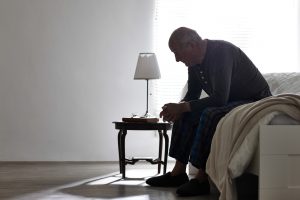Geriatric Depression and Suicide
An epidemic bridging the generation gap
 The mental health of the elderly often falls to the wayside in our conversations about the current crisis surrounding suicide. While the focus has lately been on the younger generations, who are seeing a rising number of deaths, we should never turn a blind eye to our elders. Sadly, that seems to be the case. Elderly people account for less than 10% of community mental health services even though they represent 15% of the population, a number that could begin to dwindle if we do not take their health, mental as well as physical, into serious consideration.
The mental health of the elderly often falls to the wayside in our conversations about the current crisis surrounding suicide. While the focus has lately been on the younger generations, who are seeing a rising number of deaths, we should never turn a blind eye to our elders. Sadly, that seems to be the case. Elderly people account for less than 10% of community mental health services even though they represent 15% of the population, a number that could begin to dwindle if we do not take their health, mental as well as physical, into serious consideration.
The Law Offices of Skip Simpson knows how important taking care of loved ones is. We all age, and we all want a quality of life for our loved ones that is comfortable and safe. Achieving this takes more than buying a room, a bed and a caregiver; it means seeing ourselves as caregivers to our elders’ mental health. It could mean saving lives.
Brain Age: Loss of Stability Can Lead to Loss of Life
There is a common misconception that getting older means growing content with an emotional state of nostalgia, and this misconception easily leads to the dismissal of elder mental health care. According to statistics from the CDC, depression affects up to 5% of our elderly population, and their suicides represent 16.6% of the tragic total amount in the United States. What leads to the decline in mental health that seems to plague our elder population?
As we age, we begin to lose parts of our lives that have kept us stable, or remained part of our version of normal life for as long as we can remember. Age contributes to fragile health and can lead to a diagnosis of Parkinson’s, Alzheimer’s, dementia, cancer, or general deterioration of the body that many find hard to cope with. To callous and busy medical staff, these may just be diagnostic codes, but to the patients behind the files, they mean the collapse of a lifestyle they’ve built and been accustomed to for a lifetime. Other triggers for geriatric depression include:
- The loss of a spouse, immediate family member or close friends.
- Financial difficulties.
- Loss of ability to work.
- Loss of independence due to need for caretaking, inability to work, and adult children who do not depend on them anymore; this often leads to the elderly feeling “worthless.”
- Medication side effects, as from anti-inflammatory or cardiovascular drugs.
- Isolation: As we age, socializing may become more difficult. Older patients may be in hospitals or assisted living, away from family and friends. In addition, illness prevents the elderly from living their lives with the clarity and independence that they deserve.
- Slow-acting conditions such as arthritis and macular degeneration.
All of these factors play into the rapid decline of a senior person’s mental and physical health. While we may often see older folks as infantile (a view that is often considered offensive) and simple, they have mental health needs that are overlooked on a consistent basis.
Recognizing the Signs: Red Flags in The Elderly
Older white males are at a higher risk for completed deaths by suicide in this age demographic, 29 per 100,000 and over 47 per 100,000 if over the age of 85. Due to cultural stigma trickling down from a past generation where men were not encouraged to speak about their feelings, and the systemic societal and medical problems that the elderly face, many feel silenced. They feel trapped, without the support of their families who are off living their lives while they remain stuck living alone, or in assisted living where the assistance is too often minimal. In some homes, registered nurses aren’t even on the premises most of the time, leaving patients without critical care. This problem led to the filing of a very self-explanatory bill: “Put a Registered Nurse in the Nursing Home Act of 2014.”
The statistics for elder suicide may in fact be under-reported. Very little focus is on their demographic, and the United States already suffers a startling lack of mental health support for its overall population. While it may seem difficult to recognize the signs of mental deterioration within our aging loved ones, red flags associated with the depression and loneliness that they feel are not so different than the ones we see in younger people:
- Withdrawal from social life
- Lack of interest in daily activities such as eating, socializing or basic hygiene, and a general lack of interest in life.
- Giving away prized possessions; this may seem normal as people advance in their age, but is hallmark behavior of the suicidal.
- Verbal signs such as “You would all be better off without me”
- Feeling a loss of independence
- A medical condition that could affect their impulsivity
- A recent death in the family, especially a spouse, sibling, child or pet.
- Sudden personality changes, especially with impulsive behavior
Missing the signs can mean the eventual loss of a life. Nurses and caretakers should be properly trained in recognizing when a patient or resident’s mental health begins to decline. The elderly population is often thought of as wanting to be alone, or desiring solitude to find calm. This mindset can come with a heavy penalty: death. “The proportion of older people who take their own lives without a diagnosable mental illness is very, very small,” says Dr. Conwell, a psychiatrist at the University of Rochester Medical Center.
Medical Complications: One of These Conditions is Not Like the Other
In yet another blow to the myth that aging is a peaceful and simple process, physical medical complications can contribute to the deterioration of one’s mental health. As previously discussed, the diagnosis of a medical condition can easily cause a rapid spiral into depression. However, some conditions like dementia and Parkinson’s disease can directly contribute to a lack of cognitive and emotional stability.
According to studies, the link between depression and Alzheimer’s disease is well-established. However, diagnosis may prove difficult, given that the presentation of dementia greatly varies. In one study, 11.8% of surveyed seniors with dementia lived with major depression, compared to 3.9% of seniors without dementia.
As with any condition that affects the brain, emotions can suffer. Factoring in the feelings of isolation, loss of independence and loneliness that seniors often feel can show an easily visible cocktail for major depression. Healthcare providers should take careful note to survey seniors using the Geriatric Depression Scale. Answered with a YES/NO format, these 15 questions are meant to be used as a screening for depression and depressive symptoms: 10 indicate depression when answered positively, and 5 can be indicative of depression when answered negatively. Screening, especially when a person already has a neurological condition, can help to assess the best course of action for treatment.
Medicare does cover mental health services, including prescription drugs. With not all seniors aware of their coverage, they could be missing life-saving treatment. In fact, 18 to 25% of elderly people need mental health care, but only roughly 3% of Medicare reimbursement is for mental health and psychiatric treatment.
Addiction: The Hidden Figures
Someone’s mother, grandmother, uncle, cousin or brother is caught up in the claws of addiction at this very minute. The opioid crisis is ravaging the United States, leaving no demographic untouched. With community agencies not equipped to take care of the needs of seniors, elder suicide is not often seen or dealt with by them. This leaves homeless and low-income seniors without many options for coping with their mental health. Sadly, some turn to substances in the absence of professional help.
Currently, widowers over the age of 75 have the highest rate of alcoholism in the United States. This seems to occur after the sudden loss of a partner or child, or unchecked trauma. An entire generation before us did not have access to the mental health care or even proper diagnosis for the effects of trauma or mood disorders. In an age where physical, sexual and emotional abuse were swept under the rug with most mental problems, older adults are left with untreated Post-Traumatic Stress Disorder, depression, and more.
Painkillers are an unfortunate second source of addiction. Relatively accessible for most seniors, the emotional high and relief from physical discomfort the drugs bring can be addicting at the first try.
“Chronic pain as a result of age, past injuries and other medical illnesses is certainly present in the older adult population,” said Dr. Wang of Caron Treatment Center, “It leads to prescribing painkillers for years, if not decades. “
According to research by Caron Treatment Centers, 39% of older adults entering treatment there come with a chronic pain diagnosis.
The signs of substance abuse disorder can be confused with those of aging by healthcare professionals who miss their mark. Thankfully, older adults are more likely to be willing participants in their own recovery, especially with the support of family or loved ones.
Nursing Home Protections Rolled Back
Under the new administration, the use of fines against nursing homes that harm residents has been greatly scaled back. Four of every ten nursing homes since 2013 have been cited for violations, often serious ones. While Medicare has fined two-thirds of the offending homes, the problems still exist. Failure to protect residents from circumstances that could cause injuries, neglect and bedsores are among the list of offenses.
New fining regulations in place discourage regulators from levying fines even in fatal situations. A promise to reduce the government’s presence in businesses has left many seniors at risk.
Hold Healthcare Accountable
With the demand for registered nurses to have a 24/7 presence at nursing homes, it is safe to say that at least some problems and gaps in our healthcare system have been identified. Seniors are a particularly vulnerable demographic that can easily fall between the cracks and go ignored, but they suffer surprisingly high rates of suicide. As our loved ones age, their needs for care change along with their bodies and minds. We entrust them to facilities and primary caregivers who should be screening them for depression, paying attention to changes in their behavior, offering accessible mental health, and being present when the elderly are ready to use resources available for them.
Most late-life deaths by suicide are completed, even though older adults do not attempt as often as their younger counterparts. This is largely attributed to an increased access to firearms or other lethal weapons. In some populations such as older veterans, detailed knowledge in operating them is a key factor in death by suicide. We as a society have the capacity to reduce these numbers, and we must hold the responsible parties accountable. Our healthcare has too little to offer our seniors, from the inconsistent presence of nurses in homes to the confusion of dementia and depression symptoms. Screening is in order. Proper care is in order.
If you or a loved one has lost an elder due to suicide, you aren’t alone. Help is closer than you think-contact The Law Offices of Skip Simpson today.



 In 2016, one person in the United States
In 2016, one person in the United States 
